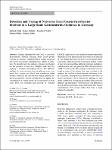Detection and Typing of Norovirus from Frozen Strawberries Involved in a Large-Scale Gastroenteritis Outbreak in Germany
Mäde, Dietrich
Trübner, Katja
Neubert, Eckehard
Höhne, Marina
Johne, Reimar
During September/October 2012, a norovirus gastroenteritis outbreak affecting about 11,000 people occurred in Germany. Epidemiological studies suggested that frozen strawberries represented the vehicle of infection. We describe here the analysis of frozen strawberries for the presence of norovirus. Samples were taken by applying a stratified subsampling scheme. Two different methods for virus extraction from strawberries were compared. First, viruses were eluted from strawberries under alkaline conditions and concentrated using a polyethylene glycol precipitation. Second, ultrafiltration was applied for concentration of viruses rinsed off of the berries. In both cases, RNA was extracted and analyzed by real-time RT-PCR. Application of the ultrafiltration method generally resulted in a lower detection rate. Noroviruses were detected in 7/11 samples derived from the lot of strawberries implicated in the outbreak using the precipitation method. Typing of norovirus revealed three different genotypes including a combination of norovirus genotype II.16 (viral polymerase) and II.13 (viral capsid). This genotype combination was also found in some of the patients that were involved in the outbreak, but that had not been reported in Germany so far. In conclusion, heterogeneously distributed noroviruses in frozen strawberries can be detected by applying an optimized combination of sampling procedures, virus extraction methods, and real-time RT-PCR protocols. The detection of several different genotypes in the strawberries may suggest contamination from sewage rather than from a single infected food handler.
No license information

